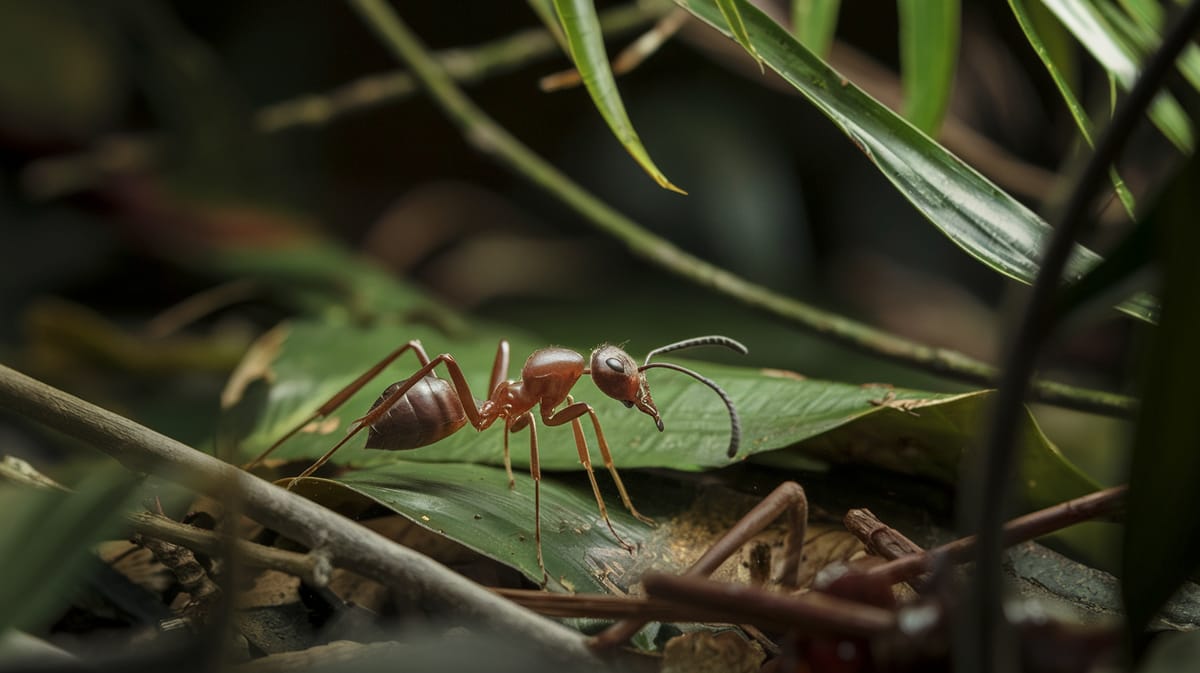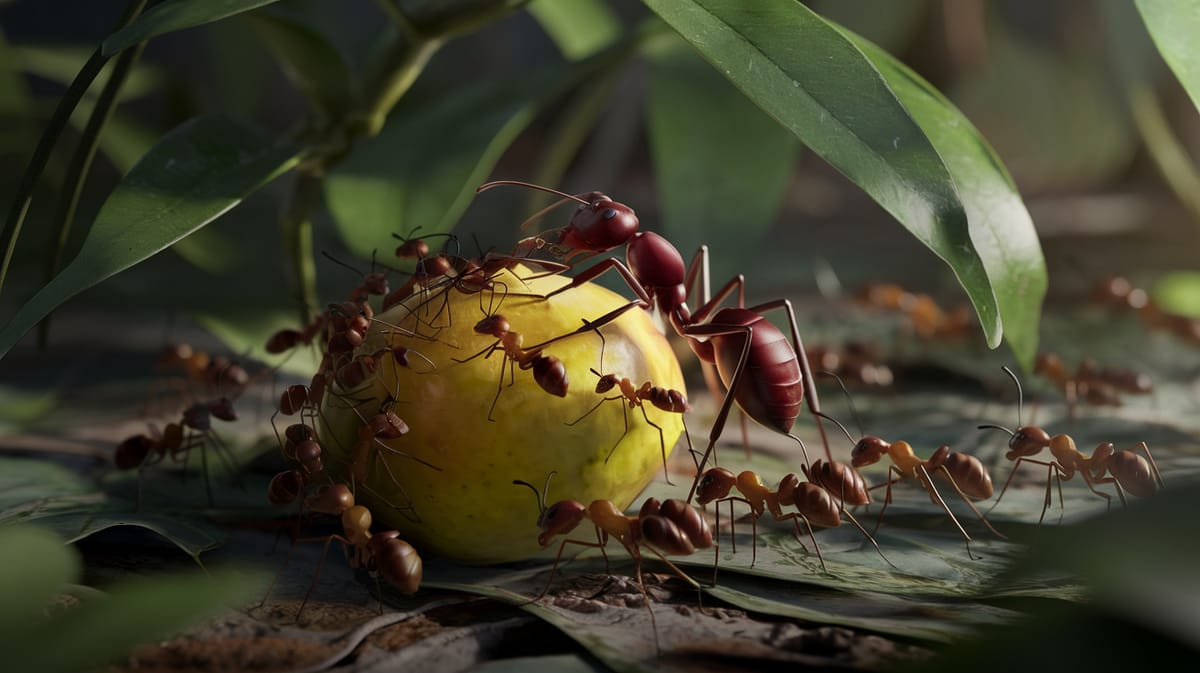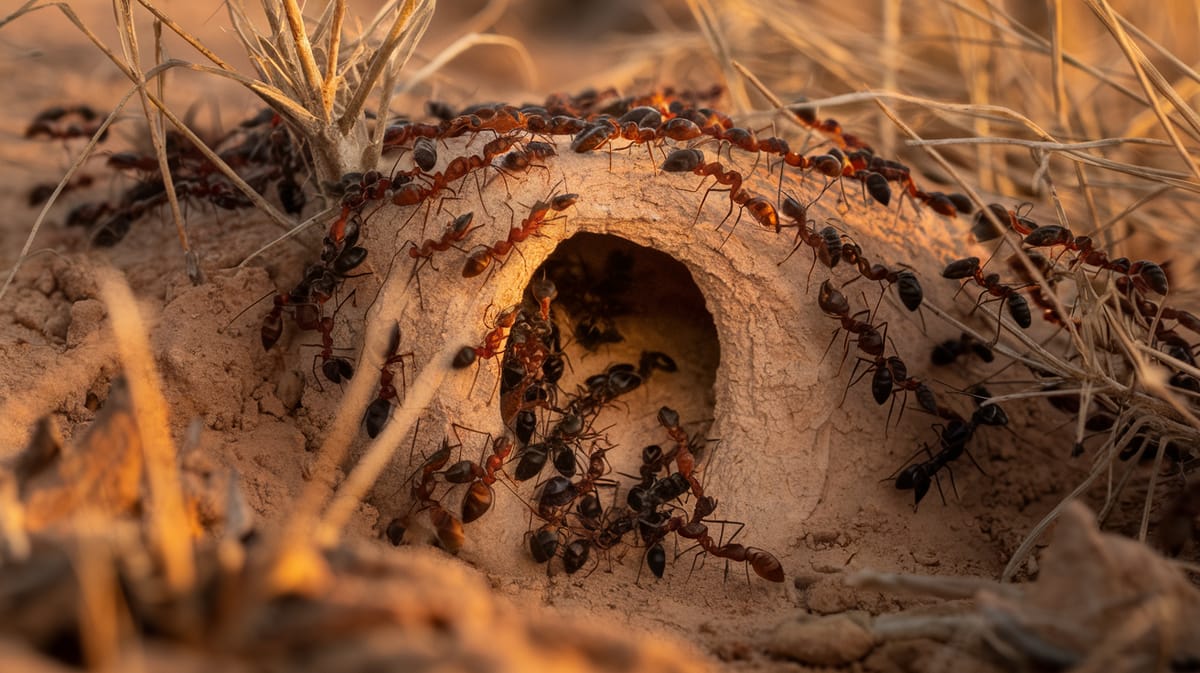Army Ant
Fierce and relentless, the Army Ants form massive columns to hunt, consuming everything in their path. Their coordinated raids play a crucial role in controlling insect populations.

Key Insights at a Glance
Did You Know?
Taxonomy & Classification
Army ants are relentless predators with a nomadic lifestyle, exhibiting complex social structures and cooperative hunting strategies. Let's understand the evolutionary journey and classification of these remarkable predators, decomposers.
Species Diversity
Army ants belong to the genus *Eciton*, which includes about 13 species, primarily found in Central and South America.
Evolutionary Adaptations
Army ants have developed cooperative foraging and brood care, evolving from primitive ancestors around 100 million years ago.
Lifecycle and Growth
A remarkable journey of transformation from Egg to Adult.
Egg
Tiny white eggs are laid by the queen, well-protected within the colony, initiating the army ant's complex life cycle.
Larva
Larvae are fed by worker ants, growing rapidly and shedding their skin several times as they prepare for pupation.
Pupa
Pupae remain immobile, undergoing metamorphosis inside cocoons, transforming into their final adult form.
Adult
Adults emerge ready to fulfill roles like workers, soldiers, or queens, with workers leading nomadic raids for food.
Dietary Habits
A relentless hunter with exceptional strategies, this insect's diet includes a variety of insects, small animals, and occasional opportunistic prey.
| DIET TYPE | DESCRIPTION |
|---|---|
| Primary Diet | Primarily preys on insects like beetles, ants, and wasps, using collective foraging tactics for efficient capture. |
| Secondary Diet | Also targets small vertebrates such as frogs and lizards, supplementing its diet with these protein-rich sources. |
| Occasional | Occasionally consumes larger prey like bird eggs or carrion, adapting to availability in its environment. |

Behaviour and Adaptations
Discover the fascinating traits that make the Army Ant a formidable force in the insect world.
Swarm Intelligence
Coordinated group behavior allows efficient foraging and overcoming prey.
Nomadic Lifestyle
Constant movement prevents resource depletion and predator saturation.
Trap-Jaw Mandibles
Powerful jaws enable swift prey capture and defense.
Ecosystem Impact
Army Ants play a crucial role in maintaining ecological balance through their diverse contributions.
Natural Pest Control
Preys on various insects, controlling pest populations naturally.
Nutrient Cycling
Breaks down organic material, aiding soil nutrient distribution.
Food Source
Serves as prey for numerous predators, supporting biodiversity.
Conservation Challenges
Understanding and addressing the critical threats to Army Ant populations.
Habitat Destruction
Deforestation and land development disrupt Army Ant colonies and their ecosystems.
Climate Change
Altered weather patterns affect food availability and migration.
Invasive Species
Competing species threaten Army Ants' food sources and habitats.
Frequently Asked Questions
How long do Army Ant live?
Army ants have a lifespan that varies depending on their role within the colony. Worker ants can live for a few weeks to a few months, while queens can live for several years. The lifespan is influenced by factors like environmental conditions and food availability.
What do Army Ant eat?
Army ants are predatory and primarily feed on other insects and small animals. They are known for their aggressive foraging behavior, often swarming in large groups to overwhelm their prey. They can consume a wide variety of arthropods and sometimes even small vertebrates.
Are Army Ant poisonous?
Army ants are not poisonous to humans. They lack venom but can be aggressive and deliver painful bites with their strong mandibles. While not toxic, their bites can cause discomfort and irritation. They are more of a threat due to their numbers and coordinated attacks.
Are Army Ant endangered?
Army ants are not currently considered endangered. They have a wide distribution across tropical and subtropical regions. While specific populations may be impacted by habitat loss or environmental changes, the species as a whole does not face significant extinction threats.
What do Army Ant symbolize?
Army ants often symbolize teamwork, cooperation, and strength due to their highly organized and coordinated behavior. They are known for working together efficiently in large numbers, which can be seen as a metaphor for unity and collective effort.
Do Army Ant bite?
Yes, army ants can bite. They use their strong mandibles to grasp and cut their prey. Although these bites can be painful, they are not venomous to humans. The pain and discomfort are usually temporary and not medically significant.
What color are Army Ant?
Army ants are typically dark brown to black in color. Their coloration helps them blend into their surroundings in the forest floor, providing camouflage as they forage for food. The specific shade can vary slightly among different species of army ants.
Does a Army Ant have wings?
Worker army ants do not have wings. Reproductive individuals, such as queens and males, do possess wings during the mating phase. After mating, queens shed their wings to establish new colonies, while the males generally die shortly after reproduction.
What does a Army Ant look like?
Army ants are medium-sized, with a segmented body comprising a head, thorax, and abdomen. They have strong mandibles and relatively small eyes. Workers are wingless, while reproductive ants have wings temporarily. Their coloration is usually dark brown or black, aiding in camouflage.
Is a Army Ant an insect?
Yes, an army ant is an insect. Like other insects, they have a three-part body structure: head, thorax, and abdomen, along with six legs. They belong to the family Formicidae, which encompasses all ant species, and are known for their complex social structures and behaviors.
Related Insects
Discover insects with similar characteristics to Army Ant - including shared habitats, diets, and taxonomic classifications
Share this profile
Help others discover Army Ant
